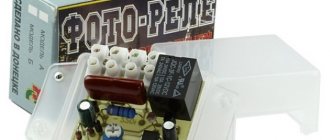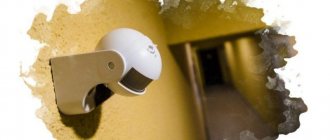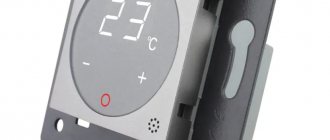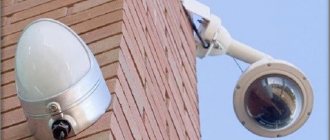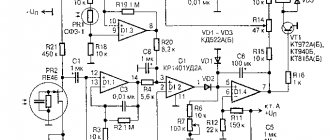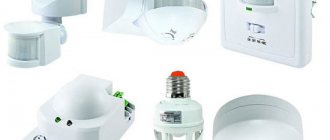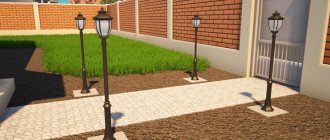- Range . There must be no less than the distance to the farthest point of the controlled zone. There is no point in overpaying for a longer range.
- Angle of control . Ceiling-type sensors in the horizontal plane control the area with a 360-degree opening. Wall-mounted – 180 or less (due to design). For wall sensors, it is desirable to control the anti-vandal zone (below the sensor) - from there, attackers can disable the device.
- Switching power . If it is not sufficient to control the existing load, you will have to install repeater relays.
- Supply voltage . If it differs from 220 volts, you will have to organize additional power sources.
- Degree of protection . Must ensure the operation of the device in the selected location - indoors or outdoors.
There are also other characteristics for choosing a sensor (color, power consumption, release time, etc.), but they are not of fundamental importance for connection and installation.
Automatic lighting control sensors
There are several main types of sensors for lamps on the market: infrared, ultrasonic, microwave and combined.
Expert opinion
It-Technology, Electrical power and electronics specialist
Ask questions to the “Specialist for modernization of energy generation systems”
Installation and connection diagram of a motion sensor: for lighting, with and without a switch. Lamps with incandescent and fluorescent lamps are not considered for installation on stairs, since the former are not economical, and the latter can harm people’s health if handled vandalously. Ask, I'm in touch!
Specifications
List of main technical characteristics:
- Color temperature (K). Determines the color perception of the glow.
- Power, W). It affects the lighting level.
- The operating temperature is from -40 to +50 degrees.
- Number of super-bright diodes in the housing (for LED lamps).
- Luminous flux (Lm).
- Angle of dispersion of the light flux.
- IP protection degree.
- List of main characteristics of the infrared sensor:
- Maximum viewing angle.
- Sensitivity (responsible for range of action).
- Operating temperature range.
Based on the type of light, LED lamps and motion sensors are divided into four types:
What kind of lighting do you prefer?
Built-in Chandelier
- Cold white. Mainly used in street lamps.
- White is neutral. Mostly used in industry and office spaces.
- Warm yellow. This type is used in apartments, residential premises and entrances.
- Multicolored. Mainly in demand in the field of design and decoration.
LED lamps can be used in different areas, and devices with a motion sensor to turn on the light in the entrance are no exception.
LED lamps with a motion sensor for LCD are powered by 220 V AC. Similarly, power can be supplied from autonomous sources - rechargeable batteries. Thanks to the development of modern technologies, solar panels are being introduced to create lighting in the entrance hall with a motion sensor.
Fixed devices use the metropolitan network. For housing and communal services, devices with a power of 6 W with an anti-vandal type of protection are used. Local areas and building facades are illuminated. For this, it is also recommended to use floodlights based on super-bright 30 W diodes with a motion sensor.
LED approach lights with a motion sensor, which uses batteries or rechargeable batteries as a power source, can also be used by technical service workers of housing and communal services organizations.
Motion sensor - connection diagram, advice on choosing an installation location and electrical installation.
The sensors have plastic housings that must be protected from shock or other damage. Particular care should be taken when handling the plastic Fresnel lens, which is an important component of the optical system of the device.
Expert opinion
It-Technology, Electrical power and electronics specialist
Ask questions to the “Specialist for modernization of energy generation systems”
Lamps with a motion sensor for the entrance - how to choose, types and best models, prices and reviews, where to buy. Outside, sensors and lighting fixtures can be installed above the entrance gate, entrance to the house, garage, bathhouse, gazebo or other premises. Ask, I'm in touch!
Who pays for the entrance lighting?
Electricity, which is spent when lighting the entrance, relates to general house needs, so the costs for it are included in the ADN. To do this, meter readings or standards are taken into account.
Usually, communal meters are installed. The readings of each apartment in the house are subtracted from the meter readings. The resulting value is divided by the number of apartments in the building, for which the square footage of each housing is taken into account.
Important! The larger the apartment, the more money the owners have to pay for one.
If the house does not have a meter, then payment is made according to the standard, and its installation is carried out by the regional administration.
To determine the fee, this standard must be multiplied by the area of the apartment, and the resulting value is divided by the total area of all apartments in the building.
Lamps with a motion sensor for the entrance: 3 types
- Significant energy savings.
- Long working life.
- Environmental friendliness. No harmful elements.
- Mains voltage range from 180 V to 240 V.
- High light output power with low power consumption.
- Does not make unnecessary noise during operation.
- Easy installation of the device.
- Easy to connect.
- Possibility of installing various types of lamps.
- Ability to configure and change the operating mode of the device depending on the degree of illumination.
- Variety of models on the market.
- Automatic lighting of dark areas in the entrance.
- During switching on, there is no load surge in the electrical network.
Internal switching.
When you open the back cover, you will see a terminal block, and three colored wires coming out from inside the case and connected to the block. Here on the left side of the block, I drew how the motion sensor should be connected. My wires also go to the left side of the block, don’t pay attention. I just didn't turn them off.
All three wires coming out from inside the case have standard colors that are used in household equipment:
1 – brown or lilac wire – incoming phase (L); 2 – blue wire – neutral wire (N); 3 – red wire – outgoing phase.
The following figure shows a complete wiring diagram for connecting a motion sensor, lamp and switch.
Phase L
(brown color) goes into the junction box, and at point
(1)
, connecting to the core of wire
A
, it is connected to the lower contact of the switch.
From the top contact of the switch, with the same wire A
, the phase at point
(2)
is connected to the core of wire
B
and goes to contact
(1)
of the sensor terminal.
From terminal contact (3)
sensor, the phase (red color) with a three-wire wire
B
goes into the junction box, where at point
(3)
it connects with the core of wire
C
, and goes to the contact of the incandescent lamp.
Neutral core N
(blue color) enters the box, where from point
(4)
it goes to the lamp and to contact
(2)
of the sensor terminal.
What are the types?
Types of lamps can be divided into several categories.
Depending on the type of installation, lamps can be of the following types:
In terms of power, devices based on ultra-bright diodes with a motion sensor are not inferior to lamps for suspended ceilings, as well as overhead LED lamps.
According to the design of the light source there are:
- Infrared. The most popular models. The operating principle is based on detecting changes in ambient temperature. Only under this condition can the device turn on. Considering that it is human nature to emit infrared light, there is no possibility of false alarms.
- Microwave. The method of operation is in many ways similar to the ultrasonic type. Only in this variety the sensor recognizes the vibration of radio waves. When the wave is interrupted, the contact closes, thereby turning on the light. Works well both outside and in entrances.
- Ultrasonic. They are most often used to create light outside. The device turns on due to the detection of a sound sensor. Also well suited for entrances and front doors.
- Combined. This type of lamp has several sensors simultaneously. This, accordingly, improves the characteristics of the device, which increases its level of efficiency in use. Now it is actively gaining popularity and is gradually replacing infrared models.
Installation Rules
It’s worth noting right away that all models have their own installation recommendations. Here we will look at the basic principle of installation, which is suitable for all types of lamps, but with certain reservations.
Note! Connection and installation of luminaires with motion sensors must be carried out only according to the drawings supplied by the manufacturer. The participation of a professional electrician is also required. The only exceptions are stand-alone models. Otherwise, the light may not turn on after connecting the device, or the lighting itself will work intermittently.
General instructions for connection and installation look like this:
- select the location of the sensor;
- A standard key sensor should be connected in parallel to the touch switch. This will protect the device from burning;
- connect the lamp with the sensor with wires;
- connect to the power line. In this case, the phase cable must go to the switch. It cannot be connected directly to the mains phase;
- then we introduce zero into the network and install grounding (if necessary);
- We isolate all contacts and configure the sensor.
Connection diagram (approximate)
Settings should be made according to the manufacturer's requirements. The method described above is used for models of wired connection to a power source (electrical network). With wireless and autonomous models, things are much simpler. The procedure for connecting a stand-alone or wireless lamp with a motion sensor is as follows:
- select the location of the sensor. The manufacturer's instructions will tell you the main indicators. Follow it strictly if you want the device to work as it should;
- You can use screws or double-sided tape as fastening elements. For entrances, it is best to choose screws;
- We drill holes and attach the sensor with a lamp to the wall or ceiling.
Autonomous lamp
Of the wires here, you only need to connect the sensor to the device. The use of lamps with built-in motion sensors in entrances allows for significant energy savings without compromising the level of illumination. And correct installation of the device will allow you to get the desired result.
How to check whether devices are connected correctly
It is best to check the functionality of these devices before installing them by connecting them according to a temporary circuit. This is especially true for simple models that do not have any adjustment controls. If after installation they do not work as expected, it is most likely due to incorrect installation.
All customizable parameters are set strictly individually in each specific room. As a rule, after the initial installation, more precise adjustments of the parameters are required during operation until the most suitable values are determined.
The usual limits for adjusting the timer response time are set in most devices from a few seconds to ten minutes. The photosensitivity threshold can only be set in devices that have an appropriate light sensor. It determines the daylight brightness at which the device stops supplying voltage to the lighting fixtures.
Setting the sensor sensitivity is the most subtle and capricious setting. In any case, the sensor should respond to the appearance of a person in the room, and not pets. When changing the viewing angle of a device, it is often necessary to also adjust its sensitivity.
Expert opinion
It-Technology, Electrical power and electronics specialist
Ask questions to the “Specialist for modernization of energy generation systems”
We choose reliable lamps with a motion sensor for the entrance. Installation of light sensors does not require any special approvals from supervisory authorities, in particular, fire supervision. Ask, I'm in touch!
Principle of operation
Internal structure of the device
Lamps that have a sensor to respond to movements in a given area are economical due to the special principle of their operation. Of course, depending on the type, the internal filling of the device may change, but the principle remains unchanged. There is a special reading device - a sensor. It constantly scans the area defined for its area of work. When movement appears in this area, the device registers it and sends a signal to the built-in light bulb. Thanks to this, the light turns on the moment a person enters the range of the lamp with a sensor. The time it takes for the sensor to evaluate the monitored area for motion may vary depending on the model. Often it is up to 10 seconds. Then, if there are no changes, the device continues to function in sleep mode.
To avoid unnecessary activation during the daytime, these types of lamps have a preset “light level” indicator. It must be set to the required level. After this, the light will turn on only when the illumination is below the set level. Thanks to this, the device will only operate at night.
